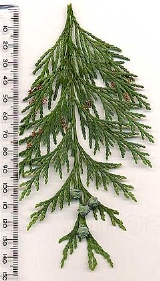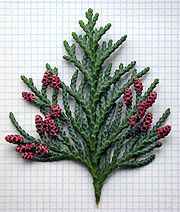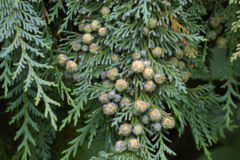
Chamaecyparis lawsoniana
Encyclopedia
Chamaecyparis lawsoniana is a cypress in the genus Chamaecyparis
, family Cupressaceae
, known by the name Lawson's Cypress in the horticultural trade, or Port Orford-cedar in its native range (although not a true cedar). C. lawsoniana is native to the southwest of Oregon
and the far northwest of California
in the United States
, occurring from sea level up to 1500 m (4,921.3 ft) altitude in the Klamath Mountains
valleys, often along streams.
It is a large evergreen
coniferous tree
, maturing up to 200 feet tall or more, with trunks 4–6 feet in diameter, with feathery foliage in flat sprays, usually somewhat glaucous blue-green in color. The leaves are scale-like, 3–5 mm long, with narrow white markings on the underside, and produced on somewhat flattened shoots. The seed cones
are globose, 7–14 mm diameter, with 6-10 scales, green at first, maturing brown in early fall, 6–8 months after pollination. The male cones are 3–4 mm long, dark red, turning brown after pollen release in early spring. The bark is reddish-brown, and fibrous to scaly in vertical strips.
It was first discovered (by Euro-Americans) near Port Orford
in Oregon and introduced into cultivation in 1854, by collectors working for the Lawson & Son nursery in Edinburgh
, Scotland
, after whom it was named as Lawson's Cypress by the describing botanist Andrew Murray
. The USDA officially calls it by the name Port Orford Cedar, as do most people in its native area, but as it is not a cedar, many botanists prefer to avoid the name, using Lawson's Cypress, or in very rare instances Port Orford Cypress, instead to stop confusion. The horticultural industry, in which the species is very important, mostly uses the name Lawson's Cypress.
The extinct Eocene
species Chamaecyparis eureka
, known from fossils found on Axel Heiberg Island
in Canada, is noted to be very similar to Chamaecyparis pisifera
and C. lawsoniana.
, with several hundred named cultivars of varying crown shape, growth rates and foliage colour having been selected for garden
planting. It thrives best in well-drained but moist soils. The wood
is light and durable, and particularly highly valued in east Asia
, with large amounts being exported to Japan
where it is in high demand for making coffin
s, and for shrines and temples. Due to the straightness of its grain, it is also one of the preferred woods for the manufacture of arrow shafts. It is also considered an acceptable, though not ideal, wood for construction of aircraft
.
. This disease is also a problem for horticultural plantings in some parts of North America
. The tree is sometimes killed, though less often, by other species of Phytophthora
.
Phytophthora lateralis infection begins when mycelium, from a germinated spore, invade the roots. The infection then spreads through the inner bark and cambium around the base of the tree. Spread up the trunk is generally limited. Infected tissue dies and effectively girdles the tree. Large trees are more likely to be infected than small trees due to larger root areas (although all trees at the edges of infected streams will eventually succumb). However, large trees can often live with the infections for a longer duration (up to several years).
Port Orford "Cedar" in streamside populations are highly susceptible to Phytophthora lateralis infection. However, the rate of Phytophthora spread through populations in dry upland areas appears to be slow. Phytophthora lateralis spreads through water via mobile spores (zoospore
s). The fungus also produces resting spores (chlamydospore
s) that can persist in soil for a long period of time. New infections generally begin when soil is transferred from an infected population to a non-infected population via human or animal movement. After initial infection in streamside populations, secondary spread via zoospores quickly infects all downstream individuals.
Human facilitated spread is thought to be responsible for most new, and all long-distance, infections. Soil on vehicle tires, especially logging trucks and other off road vehicles, is considered the most pressing problem due to the volume of soil that can be carried and the traffic rate in and between susceptible areas. Spread on boots and mountain bike tires has also been suggested and probably contributes to new infections locally. Animal facilitated spread is thought to occur, but is localized.
The Bureau of Land Management
(BLM
) and United States Forest Service
(USFS) attempt to prevent Phytophthora spread through road closures, monitoring, research and education. Research has focused on determining the dynamics and mechanisms of spread, as well as attempts to breed resistant trees.


Chamaecyparis
Chamaecyparis is a genus of conifers in the cypress family Cupressaceae, native to eastern Asia and western and eastern North America. In the nursery trade it is often incorrectly known as "false cypress" for lack of other common name, so as to distinguish it from other similar genera bearing...
, family Cupressaceae
Cupressaceae
The Cupressaceae or cypress family is a conifer family with worldwide distribution. The family includes 27 to 30 genera , which include the junipers and redwoods, with about 130-140 species in total. They are monoecious, subdioecious or dioecious trees and shrubs from 1-116 m tall...
, known by the name Lawson's Cypress in the horticultural trade, or Port Orford-cedar in its native range (although not a true cedar). C. lawsoniana is native to the southwest of Oregon
Oregon
Oregon is a state in the Pacific Northwest region of the United States. It is located on the Pacific coast, with Washington to the north, California to the south, Nevada on the southeast and Idaho to the east. The Columbia and Snake rivers delineate much of Oregon's northern and eastern...
and the far northwest of California
California
California is a state located on the West Coast of the United States. It is by far the most populous U.S. state, and the third-largest by land area...
in the United States
United States
The United States of America is a federal constitutional republic comprising fifty states and a federal district...
, occurring from sea level up to 1500 m (4,921.3 ft) altitude in the Klamath Mountains
Klamath Mountains
The Klamath Mountains, which include the Siskiyou, Marble, Scott, Trinity, Trinity Alps, Salmon, and northern Yolla-Bolly Mountains, are a rugged lightly populated mountain range in northwest California and southwest Oregon in the United States...
valleys, often along streams.
It is a large evergreen
Evergreen
In botany, an evergreen plant is a plant that has leaves in all seasons. This contrasts with deciduous plants, which completely lose their foliage during the winter or dry season.There are many different kinds of evergreen plants, both trees and shrubs...
coniferous tree
Tree
A tree is a perennial woody plant. It is most often defined as a woody plant that has many secondary branches supported clear of the ground on a single main stem or trunk with clear apical dominance. A minimum height specification at maturity is cited by some authors, varying from 3 m to...
, maturing up to 200 feet tall or more, with trunks 4–6 feet in diameter, with feathery foliage in flat sprays, usually somewhat glaucous blue-green in color. The leaves are scale-like, 3–5 mm long, with narrow white markings on the underside, and produced on somewhat flattened shoots. The seed cones
Conifer cone
A cone is an organ on plants in the division Pinophyta that contains the reproductive structures. The familiar woody cone is the female cone, which produces seeds. The male cones, which produce pollen, are usually herbaceous and much less conspicuous even at full maturity...
are globose, 7–14 mm diameter, with 6-10 scales, green at first, maturing brown in early fall, 6–8 months after pollination. The male cones are 3–4 mm long, dark red, turning brown after pollen release in early spring. The bark is reddish-brown, and fibrous to scaly in vertical strips.
It was first discovered (by Euro-Americans) near Port Orford
Port Orford, Oregon
Port Orford is a city in Curry County, Oregon, United States. It is on the southern Oregon Coast, at the northern end of what coastal Oregonians call the Banana Belt, because the weather from Port Orford south is noticeably warmer than the weather north of nearby Cape Blanco...
in Oregon and introduced into cultivation in 1854, by collectors working for the Lawson & Son nursery in Edinburgh
Edinburgh
Edinburgh is the capital city of Scotland, the second largest city in Scotland, and the eighth most populous in the United Kingdom. The City of Edinburgh Council governs one of Scotland's 32 local government council areas. The council area includes urban Edinburgh and a rural area...
, Scotland
Scotland
Scotland is a country that is part of the United Kingdom. Occupying the northern third of the island of Great Britain, it shares a border with England to the south and is bounded by the North Sea to the east, the Atlantic Ocean to the north and west, and the North Channel and Irish Sea to the...
, after whom it was named as Lawson's Cypress by the describing botanist Andrew Murray
Andrew Murray (botanist)
Andrew Dickson Murray FRSE FLS was a Scottish lawyer, botanist, zoologist and entomologist. Murray studied insects which caused crop damage, specialising in the Coleoptera...
. The USDA officially calls it by the name Port Orford Cedar, as do most people in its native area, but as it is not a cedar, many botanists prefer to avoid the name, using Lawson's Cypress, or in very rare instances Port Orford Cypress, instead to stop confusion. The horticultural industry, in which the species is very important, mostly uses the name Lawson's Cypress.
The extinct Eocene
Eocene
The Eocene Epoch, lasting from about 56 to 34 million years ago , is a major division of the geologic timescale and the second epoch of the Paleogene Period in the Cenozoic Era. The Eocene spans the time from the end of the Palaeocene Epoch to the beginning of the Oligocene Epoch. The start of the...
species Chamaecyparis eureka
Chamaecyparis eureka
Chamaecyparis eureka is an extinct species of conifer in the family Cupressaceae. It is known from fossil foliage found in the Buchanan Lake Formation deposits, dated to the middle Eocene Lutetian stage , from western Axel Heiberg Island, located in the Arctic Ocean in the Qikiqtaaluk Region,...
, known from fossils found on Axel Heiberg Island
Axel Heiberg Island
Axel Heiberg Island is an island in the Qikiqtaaluk Region, Nunavut, Canada. Located in the Arctic Ocean, it is the 31st largest island in the world and Canada's seventh largest island. According to Statistics Canada, it has an area of ....
in Canada, is noted to be very similar to Chamaecyparis pisifera
Chamaecyparis pisifera
Chamaecyparis pisifera Chamaecyparis pisifera Chamaecyparis pisifera (Sawara Cypress or Sawara is a species of false cypress, native to central and southern Japan, on the islands of Honshū and Kyūshū....
and C. lawsoniana.
Cultivation and uses
It is of great importance in horticultureHorticulture
Horticulture is the industry and science of plant cultivation including the process of preparing soil for the planting of seeds, tubers, or cuttings. Horticulturists work and conduct research in the disciplines of plant propagation and cultivation, crop production, plant breeding and genetic...
, with several hundred named cultivars of varying crown shape, growth rates and foliage colour having been selected for garden
Garden
A garden is a planned space, usually outdoors, set aside for the display, cultivation, and enjoyment of plants and other forms of nature. The garden can incorporate both natural and man-made materials. The most common form today is known as a residential garden, but the term garden has...
planting. It thrives best in well-drained but moist soils. The wood
Wood
Wood is a hard, fibrous tissue found in many trees. It has been used for hundreds of thousands of years for both fuel and as a construction material. It is an organic material, a natural composite of cellulose fibers embedded in a matrix of lignin which resists compression...
is light and durable, and particularly highly valued in east Asia
Asia
Asia is the world's largest and most populous continent, located primarily in the eastern and northern hemispheres. It covers 8.7% of the Earth's total surface area and with approximately 3.879 billion people, it hosts 60% of the world's current human population...
, with large amounts being exported to Japan
Japan
Japan is an island nation in East Asia. Located in the Pacific Ocean, it lies to the east of the Sea of Japan, China, North Korea, South Korea and Russia, stretching from the Sea of Okhotsk in the north to the East China Sea and Taiwan in the south...
where it is in high demand for making coffin
Coffin
A coffin is a funerary box used in the display and containment of dead people – either for burial or cremation.Contemporary North American English makes a distinction between "coffin", which is generally understood to denote a funerary box having six sides in plan view, and "casket", which...
s, and for shrines and temples. Due to the straightness of its grain, it is also one of the preferred woods for the manufacture of arrow shafts. It is also considered an acceptable, though not ideal, wood for construction of aircraft
Aircraft
An aircraft is a vehicle that is able to fly by gaining support from the air, or, in general, the atmosphere of a planet. An aircraft counters the force of gravity by using either static lift or by using the dynamic lift of an airfoil, or in a few cases the downward thrust from jet engines.Although...
.
Disease
In the wild, the species is seriously threatened by a root disease caused by the introduced fungal pathogen, Phytophthora lateralisPhytophthora lateralis
Phytophthora lateralis is a soil-borne plant pathogen that causes cedar root disease in Port Orford cedar trees in Northern USA. This pathogen was first noted to cause disease in around 1920 on nursery stock near Seattle WA . Pacific yew is also vulnerable to P...
. This disease is also a problem for horticultural plantings in some parts of North America
North America
North America is a continent wholly within the Northern Hemisphere and almost wholly within the Western Hemisphere. It is also considered a northern subcontinent of the Americas...
. The tree is sometimes killed, though less often, by other species of Phytophthora
Phytophthora
Phytophthora is a genus of plant-damaging Oomycetes , whose member species are capable of causing enormous economic losses on crops worldwide, as well as environmental damage in natural ecosystems. The genus was first described by Heinrich Anton de Bary in 1875...
.
Phytophthora lateralis infection begins when mycelium, from a germinated spore, invade the roots. The infection then spreads through the inner bark and cambium around the base of the tree. Spread up the trunk is generally limited. Infected tissue dies and effectively girdles the tree. Large trees are more likely to be infected than small trees due to larger root areas (although all trees at the edges of infected streams will eventually succumb). However, large trees can often live with the infections for a longer duration (up to several years).
Port Orford "Cedar" in streamside populations are highly susceptible to Phytophthora lateralis infection. However, the rate of Phytophthora spread through populations in dry upland areas appears to be slow. Phytophthora lateralis spreads through water via mobile spores (zoospore
Zoospore
A zoospore is a motile asexual spore that uses a flagellum for locomotion. Also called a swarm spore, these spores are created by some algae, bacteria and fungi to propagate themselves.-Flagella:...
s). The fungus also produces resting spores (chlamydospore
Chlamydospore
A Chlamydospore is the thick-walled big resting spore of several kinds of fungi. It is the life-stage which survives in unfavourable conditions, such as dry or hot seasons....
s) that can persist in soil for a long period of time. New infections generally begin when soil is transferred from an infected population to a non-infected population via human or animal movement. After initial infection in streamside populations, secondary spread via zoospores quickly infects all downstream individuals.
Human facilitated spread is thought to be responsible for most new, and all long-distance, infections. Soil on vehicle tires, especially logging trucks and other off road vehicles, is considered the most pressing problem due to the volume of soil that can be carried and the traffic rate in and between susceptible areas. Spread on boots and mountain bike tires has also been suggested and probably contributes to new infections locally. Animal facilitated spread is thought to occur, but is localized.
The Bureau of Land Management
Bureau of Land Management
The Bureau of Land Management is an agency within the United States Department of the Interior which administers America's public lands, totaling approximately , or one-eighth of the landmass of the country. The BLM also manages of subsurface mineral estate underlying federal, state and private...
(BLM
BLM
BLM may stand for: Saint Barthélemy using ISO 3166-1 alpha-3 country code*Bergbahn Lauterbrunnen-Mürren, a railway in Switzerland, part funicular, part adhesion*Bilayer lipid membrane*Black Mage, a job in Final Fantasy XI...
) and United States Forest Service
United States Forest Service
The United States Forest Service is an agency of the United States Department of Agriculture that administers the nation's 155 national forests and 20 national grasslands, which encompass...
(USFS) attempt to prevent Phytophthora spread through road closures, monitoring, research and education. Research has focused on determining the dynamics and mechanisms of spread, as well as attempts to breed resistant trees.



